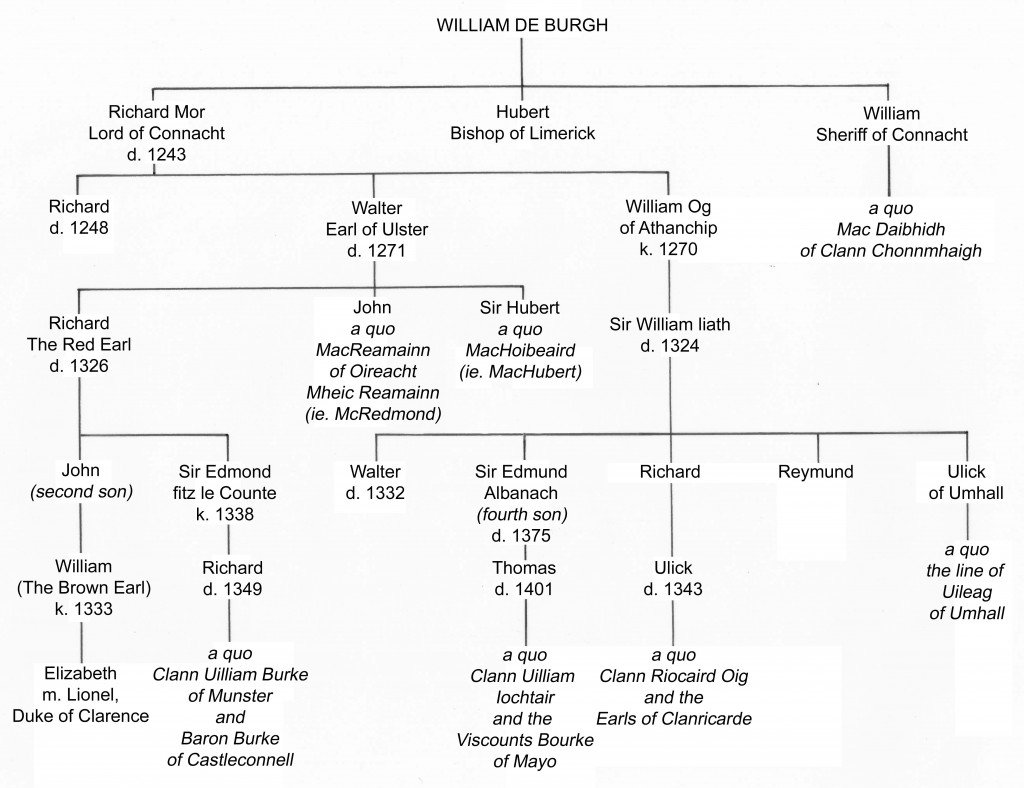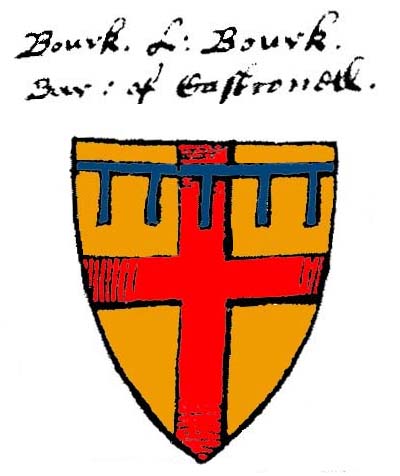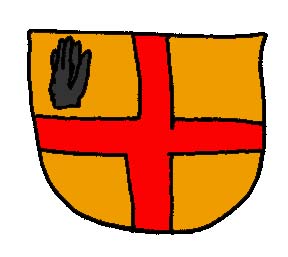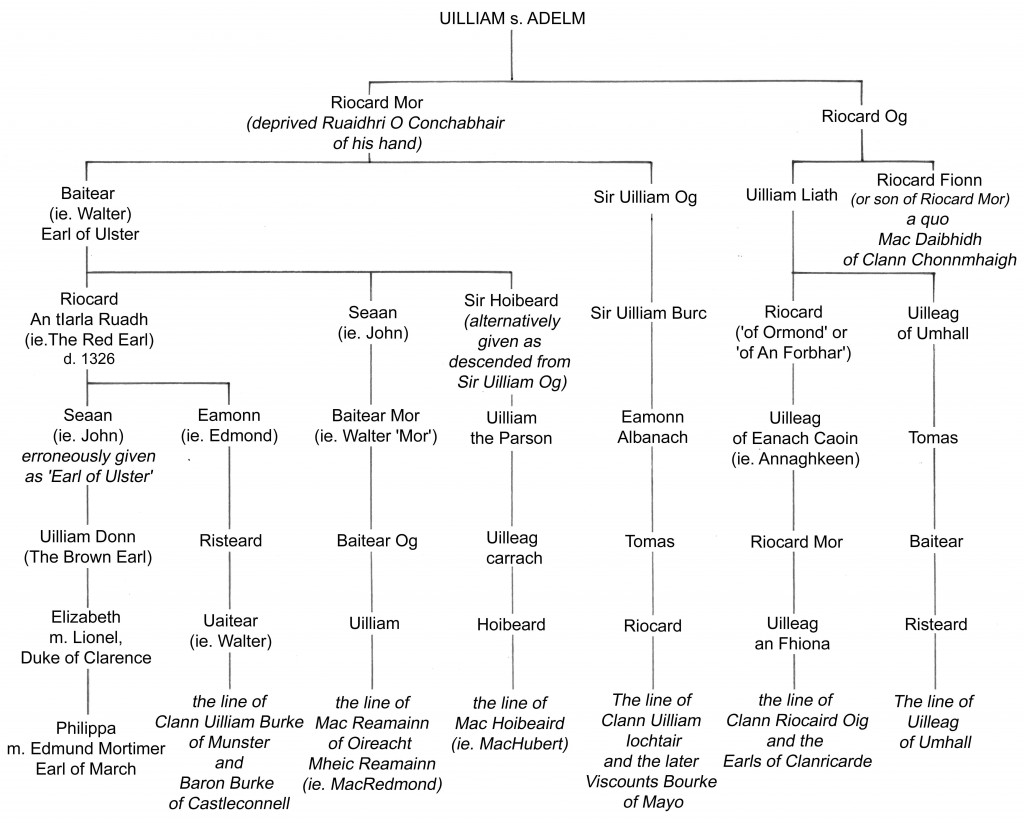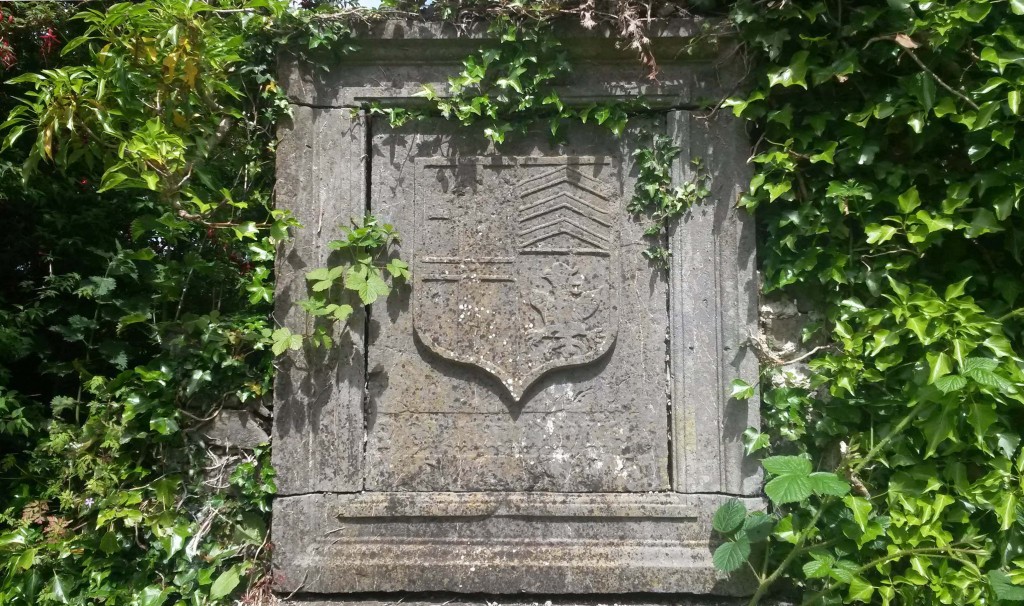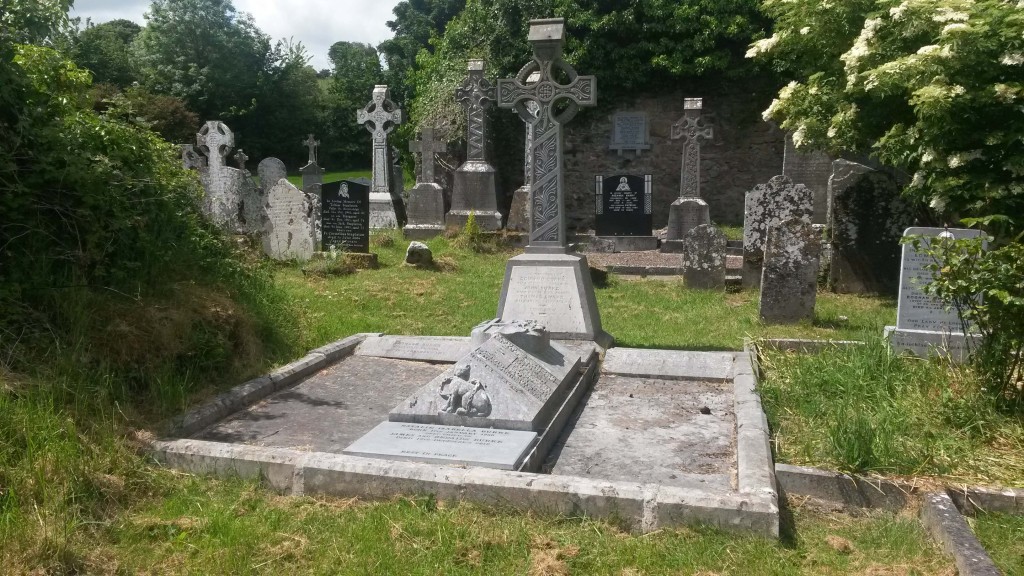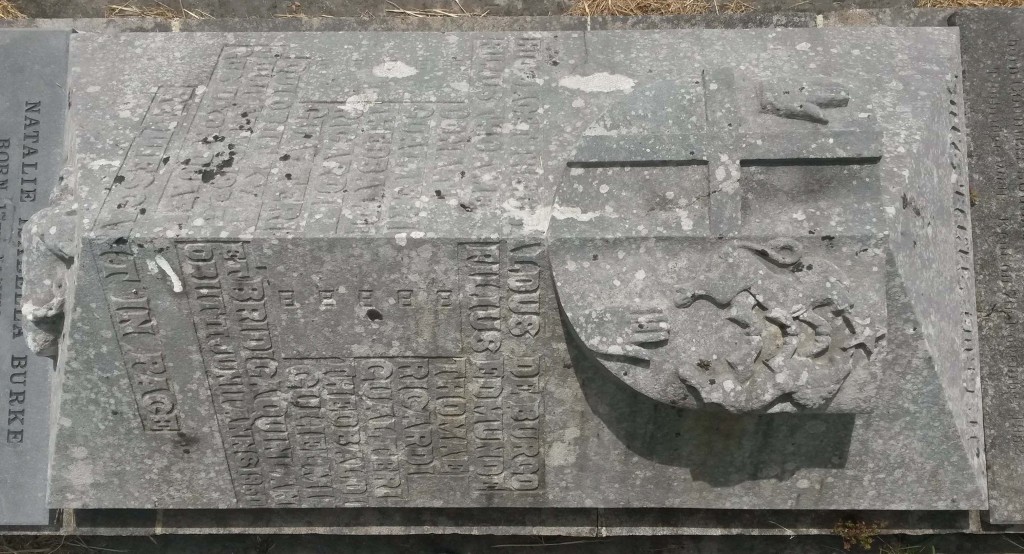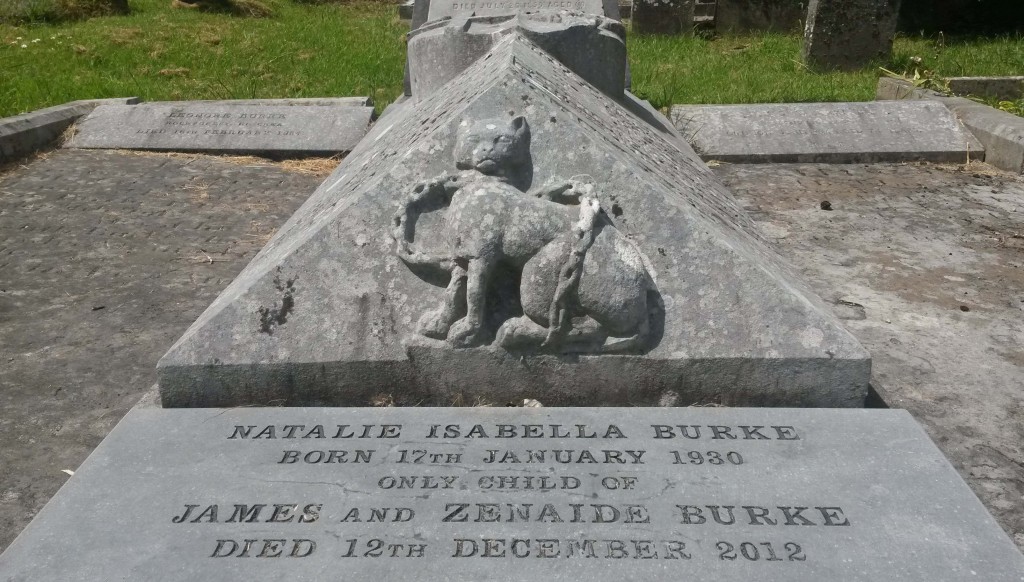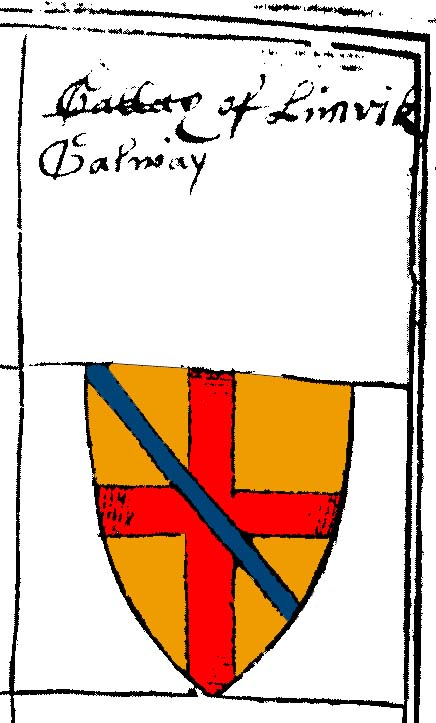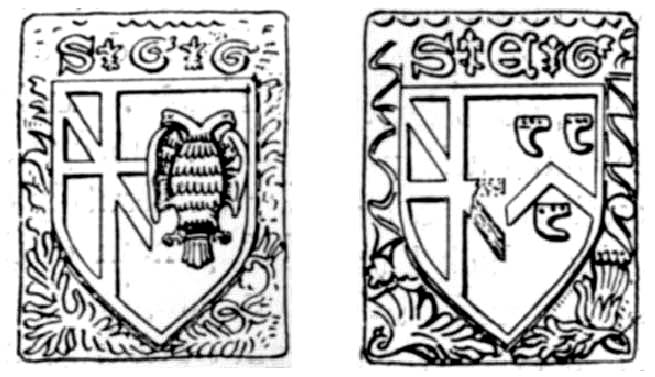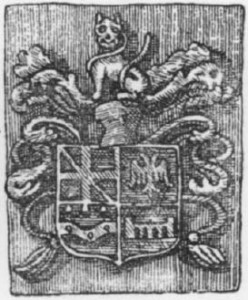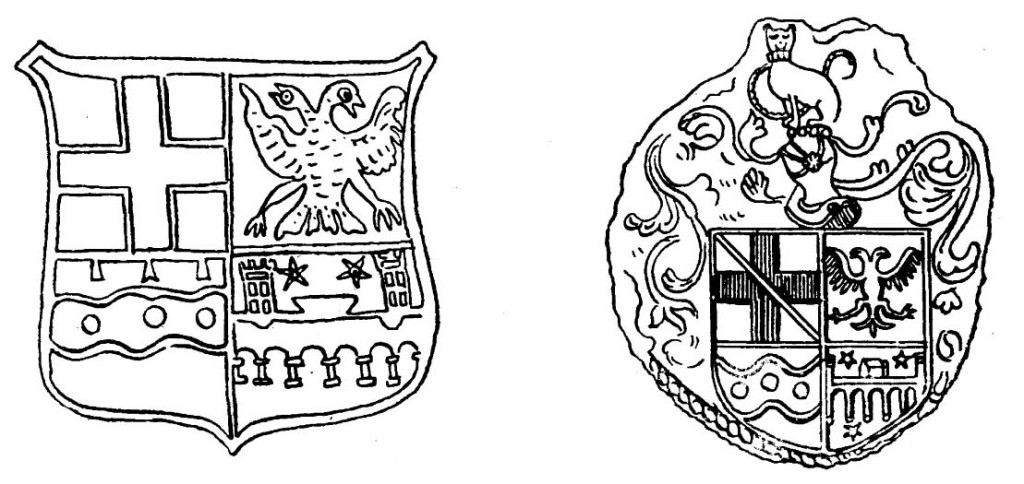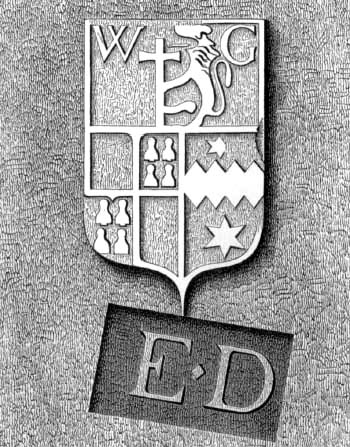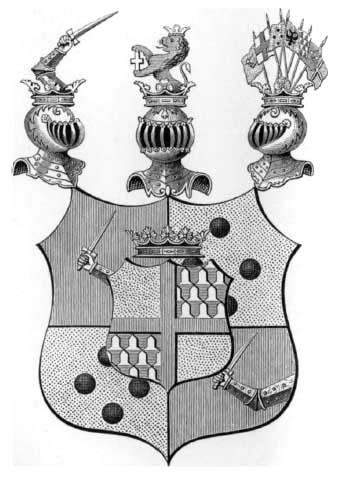© Donal G. Burke 2013
(continued from Part I)
The rise of various branches of de Burgh
In 1333 the twenty-one year old William de Burgh, Earl of Ulster and Lord of Connacht was murdered. Having no sons, the title to his vast estates passed by law to his surviving daughter and heiress and through her into the hands of a different family.
In Ireland, the most powerful members within the greater extended de Burgh family in Ireland were at odds with one another. There, the mainline descendants of Earl Walter (grandfather of the murdered Earl William), who were established in Munster and Connacht were ranged against representatives of a junior but influential line also established in Connacht, descendants of William óg of Athanchip’s son Sir William liath ‘the grey’ de Burgh. In general the grouping descended of the Earl Walter had the force of law on their side, with the most prominent man on their side, the Red Earl’s eldest surviving son Sir Edmond fitz le Counte de Burgh, being entrusted with the administration of the de Burgh lordship during the minority of the murdered Earl’s heiress. Despite this, the leaders of the opposing faction, principally Sir Edmond Albanach ‘the Scotsman’ de Burgh and his brother Reymond proved stronger, killing Sir Edmond fitz le Counte in 1338 and eventually gaining the upper hand in Connacht politics.
Over succeeding generations, as the crown lost effective control over Connacht, the de Burghs gradually became more gaelicised and two power blocks emerged, both descended from sons of Sir William liath; the Burkes of southern Connacht or Clanricarde and the Burkes or Bourkes of northern Connacht or Mayo. About these two ruling houses were various septs of Burkes descended from other branches or junior lines having branched off from the ruling house and over time losing prominence.
Over time the name de Burgh became Burke or Bourke in Ireland, based on the phonetics of the Anglo-Norman name in everyday use in medieval Ireland. As early as 1327 letters written in the Anglo-French language of the day relating to the most prominent members of the family in Ireland giving the name as ‘de Bourk,’ suggesting a close link with how the name sounded to the contemporary Irish who wrote the name ‘de Búrc,’ ‘a Búrc’ or simply ‘Búrc’.[i] The name would be written in English, often interchangeably, as Burke or Bourke.
The chief family groupings in the mid fourteenth century
The de Burghs never established a lasting line in the earldom of Ulster but by the mid fourteenth century there were several powerful branches of the de Burghs or Burkes in Connacht and Munster.[ii] The antiquary H.T. Knox classified these chief branches into four main groups;
- The mainline descended from Richard, the Red Earl of Ulster, based primarily about Limerick and Tipperary in Munster. Following the murder of the Brown Earl the foremost of these was seated about Castleconnell, northeast of Limerick, descended from the Red Earl’s son Edmond fitz le Counte. This grouping was collectively known as the Clanwilliam of Munster (as distinct from the Clanwilliam of Mayo).
- Those most closely related to the mainline, descended from the younger sons of Walter Earl of Ulster, the Red Earl’s father. It has been suggested that, in the first half of the fourteenth century, these were collectively referred to as the ‘Clann Ricaird’ or ‘family of Richard.’ Their descendants formed family groups in county Galway, the heads of which would be known by such gaelic names as MacHubert and MacRedmond Burke and possibly McCooge (McHugo). The name ‘Clann Ricaird’ was also later used to refer to the family descended from a younger son of Sir William liath de Burgh, who would gain ascendancy over the McCooges, McHuberts and McRedmond branches and rule a territory centred about Loughrea, known as Clanricarde, which would cover much of the later County Galway.
- Those descended from William óg de Burgh of Athanchip, younger brother of Earl Walter, the foremost of whom were the immediate descendants of this William’s son, Sir William liath de Burgh. From one son of Sir William liath descended the chieftains and Earls of Clanricarde in County Galway and from another the chieftains, Viscounts and Earls of Mayo. The former, after gaining supremacy among the family group originally referred to as the ‘Clann Ricaird’ and various Burkes of southern Connacht, came to be referred to as the ‘Clann Ricaird’ and it is this family group with which the name has come to be commonly associated. The latter grouping, from whom came the Earls of Mayo, were known as the ‘Clanwilliam of Mayo.’
- Those de Burghs settled about Clanconway or the barony of Ballymoe in North East Galway, now believed to be descended from one William, Sheriff of Connacht. This Sheriff William is believed to have been a younger son of William, the first de Burgh in Ireland. The head of this grouping, established about Glinsk, became known as MacDavid Burke and appears to have been a distinct line from the mainline from the third generation of de Burghs in Ireland.
Non-exhaustive pedigree table showing selected branches of the Burkes. H.T. Knox gives an alternative line of descent for the chieftains and Earls of Clanricarde.
Historians in the modern period have compiled pedigrees of these families based on a comparison of early pedigrees and Irish annals with contemporary English administrative records. However, contradictory pedigrees existed in the sixteenth and seventeenth century which would have informed how members of the family and heralds understood their relationship to one another and to the mainline of the de Burgh Earls at that time.
Both the more senior houses of Burke and the junior armigerous lines would bear arms based on the pronominal ‘Or a cross Gules’, but with various differences. These armorial differences did not always accurately or consistently represent their actual descent, or distinction, from the mainline of the last de Burgh Earl of Ulster and may rather have been influenced by the prevailing view of their pedigrees in the late medieval and early modern period.
Ulster King of Arms
In the period from the late fourteenth century to the late sixteenth century, there was little or no regulation of heraldry in the regions of Ireland remote from English control and the Crown did not establish an office or herald to deal specifically with the question of Irish arms until the appointment in 1552 of the first Ulster King of Arms with jurisdiction over the country. The Crown only began to make significant progress in re-establishing its authority over much of Ireland under the Tudor Kings and Queens of England from the mid to late sixteenth century. With that expansion of influence came a renewed regulation of armorial bearings.
Burke of Castleconnell, Brittas, etc.
The principal descendant branch of the original mainline from Walter Earl of Ulster was established about Castleconnell, near Limerick, in Munster. This branch was descended from Edmund fitz le Counte de Burgh killed in 1338, son of the Red Earl. Following the death of his brothers Walter, John and Thomas and the murder in 1333 of his nephew William Earl of Ulster, Edmond fitz le Counte was the senior-most surviving son of the Red Earl and the senior-most male of the de Burghs in Ireland in line of descent. A number of armorial bearings were associated with the descendants of this Edmund fitz le Counte, with certain of the earliest displaying either the simple Or a cross Gules without any charge in the cantons or with a couped hand in the dexter canton.
The Red Earl had borne for arms the simple ‘Or a cross Gules’ and his second son John, after the death of the Red Earl’s eldest son, bore a label of three points upon the same shield, indicating his position as the new heir. As John then died during the lifetime of his father, the heir became John’s young son William, who succeeded to the title, estates and arms after the Red Earl’s death in 1326. As William was murdered and left only one surviving heiress, her husband’s descendants by law inherited the earldom and the estates of the Earl’s and incorporated the de Burgh arms on occasion into their heraldic achievement. Although Edmond fitz le Counte de Burgh was the senior-most surviving male of the name at his death, there is little evidence to determine the arms borne by him or his son Richard, who died of plague in 1349.
The foremost individual of this branch, William Burke, was created Baron Burke of Castleconnell in 1580. A compilation of arms relating to Ireland from the office of the then Ulster King of Arms, dated about 1606, gives the arms of Lord Burke, Baron of Castleconnell as ‘Or a cross Gules a label of five points Azure.’[iii] The label since early times had been in use to signify an heir and it is noteworthy that at the death of Sir William Burke, Lord of Castleconnell, in 1586 the Irish annalists were aware of the genealogical prominence of this line and call him ‘the Red Earl’s heir.’ The arms with this label would appear to be an accurate heraldic representation of the armiger (ie. the arms bearer).
Arms of ‘Bourk Lord Bourk, Baron of Castlconell’ after tricked arms in Harl. Ms. 5866, dated circa 1606.
However, another armorial compilation relating to Irish arms dating from about 1603 gives the arms of the same William Burke, Baron of Castleconnell as ‘Or a cross Gules in the dexter canton a dexter hand couped at the wrist Sable.’[iv]
Shield of ‘William Bourke Baron of Castle Connill in Munster,’ after tricked sketch in Harl. Ms. 5885, dated circa 1603.
The origin of this ‘hand’ charge occurring in certain Burke arms is uncertain. It has been suggested that it represents a tradition that an early de Burgh defeated Rory son of Turlough mór O Connor in ‘the battle of Áth an Luaithrigh’ and in doing so cut off O Connor’s hand ‘with one sword blow’.[v] The event itself appears to have been a later fabrication but the tradition was repeated by the Gaelic genealogist Dubhaltach MacFirbisigh in the mid seventeenth century in his ‘Great Book of Genealogies.’
Both MacFirbisigh and a late sixteenth century genealogical tract entitled ‘Historia et Genealogia Familiae de Burgo’ give an erroneous descent for the later Burkes of Clanricarde in County Galway. Both state that the mainline of the Earls of Ulster, from which the Burkes of Castelconnell, Brittas and others in Munster were descended, derived from Richard mór (ie. ‘the elder’ or ‘great’), son of that William, progenitor of the de Burghs in Ireland. While this element of their pedigrees is correct, both also state that William, the progenitor, had a second son by a second wife, also named Richard and differentiated from the elder by being identified as Richard óg (ie. ‘the younger).[vi] From this younger Richard these two accounts erroneously state that the later Burkes of Clanricarde descended.[vii] This same pedigree involving the brothers Richard Mór and Richard óg also occurs in O Clery’s early to mid seventeenth century ‘Book of Genealogies.’[viii]
The defeat of O Connor and the removal of his hand was attributed to the elder brother; Richard mór. While it is uncertain if this is the origin of the heraldic charge, the hand appears in certain late sixteenth and early seventeenth century heraldic sources in the arms of the Clanwilliam Burkes of Mayo and those of Castleconnell, etc., and not in those borne by the Burkes of Clanricarde or the MacDavid Burkes of Glinsk.[ix] This may be accounted for by the erroneous contemporary belief that the latter two were not derived from ‘Richard mór’ but ‘Richard óg.’[x] As such the bearing of the hand in the heraldic arms associated the armiger in Gaelic Ireland with descent from the senior line from whom came the mainline of the Earls of Ulster and Lords of Connacht.
A seventeenth century understanding of the descent of the Burkes, compiled from MacFirbisigh’s ‘Great Book of Genealogies.’
MacFirbisigh’s pedigrees have proven unreliable when dealing with the very earliest generations of the Burkes in Ireland and it is now generally accepted that the first William de Burgh in Ireland had only one son of the name Richard (‘Richard mór’) from whom the mainline of the Earls, the Burkes of Castleconnell, etc., the Clanwilliam Burkes of Mayo and the Burkes of Clanricarde were descended.
The Barons of Castleconnell, however, would be found bearing ‘Or a cross Gules, in the dexter canton a dexter hand couped at the wrist Sable’ into the late seventeenth century, with the coat of arms and banner, without crest, of Bourke, Baron of Castleconnell given as such in the records of the Ulster King of Arms circa 1640.[xi]
A junior scion of the Castleconnell family, Theobald, son of Theobald son of William 1st Baron of Castleconnell, was created Lord Bourke, Baron of Brittas in County Limerick in 1618.[xii] Following his death in 1654 he was succeeded to the Brittas title by his son John, who married Margaret, daughter of Thomas Fitzmaurice, 16th Baron of Kerry and Lixnaw.
The impaled arms of this John, Lord Bourke, Baron of Brittas appear to be recorded in the records of the then Office of Arms giving his death on the 6th January 1658.[xiii] The impaled arms of this individual are shown with the arms of Burke on the dexter half, tricked as Or a cross Gules, a fleur de lis at centrepoint. On the sinister half was displayed the arms of Fitzmaurice, Argent a saltire Gules a chief Ermine. In this case, no charge was given in any canton in the Burke arms. It would also appear that the fleur de lis upon the cross may have been a charge rather than an individual’s own cadency mark, as the fleur de lis would have indicated the sixth son of the armiger’s father, marks that were reputed to have been introduced by Garter King of Arms as a system of distinguishing brothers from circa 1500. Theobald Lord Bourke, 1st Baron of Brittas was the fourth and youngest son of his father while this John, Lord Bourke, 2nd Baron of Brittas was said to be the eldest of his father’s two sons.[xiv] The funeral entries in the office of the Ulster King of Arms do not appear to have included the crest of the Castleconnell or Brittas armigers in their contemporary records.
However, Sir Bernard Burke in his ‘General Armory of England, Scotland, Ireland and Wales’ later gave for the arms of Bourke Lord Brittas as ‘Or a cross Gules in the first quarter a dexter hand couped at the wrist Sable’, the same shield as that of Castleconnell. [xv]
MacWalter Bourke of Ileagh, Co. Tipperary
Another line of the de Burghs, established in a small territory in the north of County Tipperary, became identified as a minor sept or branch in its own right, known as the Bourkes of Ileagh, the head of their branch known as MacWalter Bourke of Ileagh.[xvi] It is uncertain from whom this sept derive their descent and although a funeral entry in the records of the Ulster King of Arms for a senior family member dated 1635 described them as ‘descended from the Bourkes of Clanricard,’ they came to bear arms similar to those of Castleconnell. The head of this family, Walter Bourke of Burres (Borrisoleigh), County Tipperary died on 10th June 1623 and was buried at Glenkeen graveyard, near Borrisoleigh.[xvii] The arms carved in relief over his wall tomb are said to bear his paternal arms impaled with that of his wife, Silia or Sheila daughter of O Dwyer, given that the associated inscription on the table below the arms relate to both individuals and their four named sons and various unnamed daughters. M. Callanan described these arms in the early twentieth century as ‘the de Burgo arms, a cross, in the dexter canton the badge of Ulster impaling those of O Dwyer, a fesse, in chief three chevrons, in base an eagle displayed, the whole surmounted by a helmet.’
The arms on the stone tablet above the wall tomb were impaled arms, but those of Bourke, on the dexter side, are composed of a simple cross upon a plain ordinary, in the top dexter canton a dexter hand couped at the wrist, a cross Moline at centrepoint. (The arms of this Bourke’s wife’s family on the sinister half were carved as per fess, in chief three chevronels, in base an eagle displayed, but from another example elsewhere by the same sculptor appear to represent three chevronels upon a plain ordinary, an eagle displayed in base. The sinister arms, however, do not appear to be those later associated with O Dywer.)[xviii] No helmet appeared upon the Bourke memorial, which appears to have been executed in a style reminiscent of the seventeenth century.
Near the foot of this wall tomb, within the remains of the ruined church at Glenkeen, was another grave to later members of a prominent Burke family, upon which was carved armorial bearings similar to those of the wall tomb. A pedigree inscribed on the slab would suggest that those buried beneath were directly connected with, or descended from, that Walter of Burres who died in 1623.[xix] This graveslab, dated from the early decades of the twentieth century, was erected to the memory of Theobaldus de Burgo, who died on the 15th June 1925 and his wife Bridget Quinlan, who died in June 1930. The Theobaldus mentioned in the Latin inscription on the stone is a reference to Tobias Henry Bourke and upon the slab was carved in high relief the same Bourke arms, without the cross moline, impaled with arms of two lions rampant combatant, in chief a mullet, a dexter hand couped at the wrist in base, the arms of the Quinlan family. At the base of the slab was carved a cat a mountain sejant guardant collared and chained, the chain flexed over the back. At the head of the slab appeared the motto ‘in cruce semper salus.’
The burial place of Tobias Henry Bourke of Rockforest at Glenkeen
Detail of the impaled arms of Tobias H. Bourke of Rockforest carved on the sculptural gravestone of the family burial place at Glenkeen
Detail of the crest of the Bourkes of Rockforest at Glenkeen
These paternal arms were confirmed on the descendants of this Tobias Henry Bourke and his son James Aloysius Bourke, both of Rockforest two years before the death of Tobias.[xx] Within the boundaries of this family burial plot appears a slab to the memory of James A. Burke, B.L. of Rockforest, Roscrea, County Tipperary, who died on the 10th June 1967, aged 74 years. From the arms of this James Aloysius Burke, gentleman, Barrister at Law, T.D., Parliamentary Secretary to the Minister for Finance of the Irish Free State (a founder member of Cumann na nGaedhael and later of the Fine Gael political party), given in Fox-Davies ‘Armorial Families’ may be derived the tinctures of the arms on the family stone, ‘Or a cross Gules, in the first quarter a dexter hand couped at the wrist Sable’, with mantling of Gules and Or and for crest, upon a wreath of the colours a cat a mountain sejant guardant Sable, collared and chain Or, and for motto, ‘a cruce semper salus.’[xxi]
McCooge, McHubert and McRedmond Burke
There would appear to be no evidence in the Office of Arms of a record dating from about the seventeenth century giving the arms used or claimed by either the McCooges (McHugos), McHubert Burkes or MacRedmond Burkes, septs believed to be descended from younger sons of Walter Earl of Ulster.[xxii] (Uncertainty, however, surrounds the descent of McCooge.)[xxiii] All of these branches were established about the later County Galway, within the territory of Clanricarde. McCooge’s lands lay about Lough Rea, for the most part in the parishes of Loughrea and Killeenadeema, McHubert’s about Isserkelly, south west of Loughrea and McRedmond’s in the barony of Kiltartan. Despite their seniority in line of descent from the mainline of the Earls of Ulster, they came to be dominated by a more junior line descended from a younger son of Sir William liath de Burgh, the Red Earl’s cousin. This more junior line held the chieftaincy of the territory of Clanricarde in the late medieval period and provided the line of the Earls of Clanricarde from the mid sixteenth century.
Arms of a number of families associated by tradition with the mainline
A small number of families other than that of Burke bore arms that asserted their descent from the de Burghs, two of which were Galwey and Gall or Gaul, but the documentary evidence to support this assertion is slight. The arms used by members of both families were supportive of their genealogical claims. Both bore variations of the simple ‘Or a cross Gules’ of the mainline, without charges in the cantons.
Galwey of County Limerick
Members of the name Galwey were prominent merchants in Munster in the fifteenth, sixteenth and seventeenth centuries. While tradition asserted their descent from a senior line of the de Burghs, at least one of the name Galweye was a merchant in Ireland in the late thirteenth century. In 1285 Fra’ William, Prior of the Hospital of St. John of Jerusalem in Ireland, then serving as Deputy Justiciar of the country, ordered the officials of the exchequer to pay Richard Weston and Walter Galweye for ‘four tuns of wine bought from them for the King’s use.’ The wine had been purchased for the use of the King’s army led by Fra’ William who had recently been engaged ‘against the king’s enemies disturbing the peace in Connacht.’[xxiv]
This Walter is unlikely to have been born much later than circa 1260 and so was of the same generation as Richard de Burgh, the Red Earl of Ulster. There is no suggestion that this Walter Galweye was in any way connected with the de Burgh mainline and is unlikely to have been the case at this early stage. While the name may have been derived from the nascent de Burgh town of Galway, the name itself or similar was not confined to Ireland, with another of the name ‘de Galweye’ a burgess of Newcastle on Tyne in England in 1304, which may suggest an alternative origin.[xxv]
The arms used by the Galweys of Limerick from at least the fifteenth century appear to be those of de Burgh with a bend for variation, which would suggest that, at the very least, the tradition of their descent from de Burgh dated from an early period. As ‘Galway of Limrik’ (recte: Limerick), their arms were shown tricked in the records of the Ulster King of Arms about 1603 as ‘Or a cross Gules with a bend Azure over all.’[xxvi]
Arms of ‘Galway of Limrik’ after Harl. Ms. 5866, dated circa 1606.
The tomb of this family at St. Mary’s Cathedral in Limerick, erected by one Edmund son of Geoffrey Galwey and Margaret daughter of Richard Bultingfort, carried a number of armorial bearings. One of those was that of Edmund Galwey bearing a shield with a cross as an ordinary and a bend over it impaling that of Artur. The same tomb carried the tablet to one Geoffrey Galwey with the same arms of Galwey impaled possibly with that of Stritch[xxvii] and the bearings of Richard Bultingfort, a wealthy citizen with interests in Limerick and Cork, with whose family the Galweys were intermarried.[xxviii] Geoffrey Galwey, who died on the 4th January 1445, was a merchant trading in a variety of goods, such as linen, hides, salt and honey, whose will, in which he left legacies to churches in Limerick, Kinsale, Youghal, Kilmallock, Timoleague, Dungarvan and Adare show interests across Munster.[xxix]
Impaled arms of Geoffrey Galwey (left) and Edmund Galwey (right) from the Galwey monument in the south transept of St. Mary’s Cathedral, Limerick. (from the Journal of the Royal Society of Antiquaries of Ireland, Vol. 8, 1898.)
Above the late fifteenth century tomb armorial bearings in Limerick an armorial stone was erected at a later date. These arms appear to be those of a later member of this family, incorporating elements of the Stritch and possibly that of Bultingfort and more elaborate than the simple cross and bend. These arms were illustrated by Thomas Westropp in the late nineteenth century as; quarterly, 1, a cross with a bend thereon for Galwey; 2, a double headed eagle; 3, a fess wavy with three plates thereupon and what may have been a label of three points above (suggested by Westropp as an incorrect version of the Bultingfort arms; 4, a bridge with a tower at either end (suggested by Westropp as a portrayal of Ball’s bridge, which by tradition a member of the de Burghs, ancestor or relative of the Galweys defended against the O Briens in 1361). The arms appear in the style of the seventeenth century and bore, above the shield and mantling, a helmet and crest of a chained cat a mountain sejant guardant with chain and tail flexed.[xxx] The crest, similar to that of many of the Burkes, again served to reflect their claim of a shared descent from the de Burghs.
Quartered arms of Galwey above the Galwey monument in the south transept of St. Mary’s Cathedral, Limerick. (from the Journal of the Royal Society of Antiquaries of Ireland, Vol. 2, 1892, illustrated by T. J. Westropp.)
The arms above the Limerick tomb are almost identical with those atop a tomb dated 1627 in the Galwey family chapel in the Church of St. Multose at Kinsale in County Cork as illustrated also by Westropp. In this case, while no crest is shown, the only difference is that the bend is not evident on the Galwey quarter and the fourth quarter, displaying the bridge, two mullets are displayed above the bridge.[xxxi] Westropp makes the comparison between both of these arms with that given on the seal of one Sir Geoffrey Galwey dated 1636. The seal gives an identical cat a mountain crest above a helmet and mantling and the shield is shown quarterly as per the arms above the Limerick tomb. The first quarter displayed the cross and bend of the Galweys and in the fourth quarter, two mullets appear above the bridge and a third in base.[xxxii]
Quartered arms at Galwey tomb, Kinsale (left) and the seal of Sir Geoffrey Galwey, dated 1636 (right). (from the Journal of the Royal Society of Antiquaries of Ireland, Vol. 8, 1898.)
The descent of this Sir Geoffrey Galwey given as his being the son of James Galwey, alderman of the city of Limerick, son of John of the same place, son of Geoffrey Galwey of Kinsale, County Cork.[xxxiii] Sir Geoffrey Galwey was created a baronet in the reign of King James I and died in 1636. He was married on three occasions and by his first marriage had at least three sons and five daughters, two of whom married men of the Stritch family of Limerick.[xxxiv] His eldest son, John, died in his father’s lifetime and Sir Geoffrey Galwey was succeeded to the baronetcy by his grandson Sir Geoffrey Galwey, bart. This grandson, born about 1617, was a prominent lawyer who served as mayor of Limerick in 1600 and was hanged by the Cromwellian Henry Ireton on their taking of the city in 1652.[xxxv] The baronetcy died about 1700 on the death of the third baronet, Sir James Galwey.
The arms of the executed Sir Geoffrey was given by O Hart in the late nineteenth century, however, as different from those on his fathers seal. O Hart gives his arms as ‘Or, on a cross gules, five mullets of the field.’ This, however, may be a reflection of the arms of a junior branch of this family, who later rose to prominence in County Cork.
Gall Burke of Gallstown, County Kilkenny
Another family claiming descent from a senior branch of the de Burgh mainline was that of Gall or Gall Burke, seated at Gallstown Castle in the south of County Kilkenny. It is held by family tradition that this family of Gall were originally of the name de Burgh and of the mainline of the Red Earl. The ‘Gall’ being a reference to their foreign origin, a Gaelic word to indicate a foreigner or one of Anglo-Norman extraction. Their arms reflect the arms of the mainline ‘Or a cross Gules’ but with an alteration of the field, showing Vair in the second and third cantons.
The impaled arms of one of this family were carved on a keystone above the castle gate at Gallstown. While the date of the stone was later knocked off by a mason when the stone was relocated following the demolition of the castle, the arms have been attributed to Walter Gall of Gallstown, (who signed himself as ‘Walter Gall Borke’) who died in 1642 at the age of sixty-seven years.[xxxvi] He was married to Ellise Denn whose family arms were believed by the antiquary John O Donovan to be those on the sinister half of the shield. The rudely carved shield displayed on the husband’s dexter side a simple cross as ordinary with Vair in the second and third cantons and are intended to represent Per a cross Gules Or and Vair counter-charged. His wife’s family arms appear as a fess dancettée between two mullets. Above the impaled shield for crest was a primitive lion rampant holding an elongated latin cross between the initials ‘W.G.’
The impaled arms carved as part of an arch’s keystone above the gate of Gallstown Castle in County Kilkenny and believed to have been the arms of Walter Gall Burke impaled with those of Denn. After the castle was destroyed some time after 1798, parts of the stone, with the original initials E.D. and the accompanying date were destroyed by a mason when using this stone in building the gable of a house. The local priest, seeing the mutilation, instructed the mason to carve anew the initials for posterity, thus explaining the difference in style. This house was later demolished by the mid nineteenth century and the stone used as a high-level corner stone in the construction of an out-building of one Mr. Jones of Mullinabro and concealed under render. (from ‘The Journal of the Kilkenny and South-East of Ireland Archaeological Society’, Vol. 3, 1860.)
This Walter Gall Burke who died in 1642 was given on his funerary monument in Gaulskill church in Co. Kilkenny as ‘Walter fitz Piers Gaul alias Burke’ and appears to have been son of one Piers Gaul or Gall of Gallstown who was pardoned by the Crown in 1585 and later served as Constable of the barony of Ida, Igrine and Ibercon in 1608.[xxxvii] Piers in turn appears to have been the son of Walter Gall alias Burke who served as Member of Parliament for County Kilkenny in 1559 and later as Sheriff of that county from 1572 to 1574.[xxxviii]
Walter Gall of Gallstown who died in 1642 had at least one son and one daughter, Richard Gall of Rathnesmolagh, who was living in 1632 and Catherine Gall, married to an ancestor of the antiquary John O Donovan. Richard, however, appears to have died without male heirs. It has been suggested by O Donovan that the Walter who died in 1642 had five younger brothers; William, James, Patrick, David and Thomas, all of whom pursued a military career on the Continent in the service of the ruling Catholic houses of Austria and Spain.[xxxix] However, the Rev. William Carrigan suggested that the five brothers may have been younger sons of that Walter of 1642.[xl] In either case the brothers appear to have been descended from the family of Gallstown.
William first served in the Polish army and then for about twenty years in that of the Holy Roman Emperor. He raised a regiment of dragoons of which he was proprietor up to 1644 and was Colonel commanding a regiment of cuirassiers that he raised in 1640.[xli] He also served as Chamberlain to the Holy Roman Emperor Frederick II and his successor Frederick III. As ‘Wilhelm Gall à Bourke, Colonel and Chamberlain’, he petitioned the Emperor to be raised to the rank of Count.[xlii] Frederick II having died before the process was completed, his successor Frederick III created William a Count of the Holy Roman Empire in 1637 in recognition of his many services and those of his four brothers, three of whom, James, David and Thomas had been killed in action. In granting the title of Count and ‘Wohlgeboren’ to William or Wilhelm, the Emperor provided for it to descend after him to ‘all his present and future lawfully begotten heirs of his body and their heirs descending in the male and female line.’ The diploma, dated 2nd June 1637, also provided for an augmentation of his family arms and the right to adopt by deed or by his last will any of his brothers (Thomas as ‘Thomas Gall Freyherr von Bourgkh’ being the last surviving brother on the Continent) in case of want of male issue.[xliii]
The patent of nobility for this ‘Wilhelm Graf von Gall, Freiherr von Bourgkh, Kaiser Kamerer und Oberst’ (Chamberlain and Colonel) made reference to the numerous wounds on his body and four ‘deadly shots’ he received over a long and dedicated military career. The augmented arms, copied from the original diploma by Charles Count MacDonnell in the nineteenth century, included an heraldic reference to those wounds that Wilhelm carried on his body. The same augmented arms were described as ‘Quarterly: first and fourth, Gules, issuing from the sinister side an arm embowed, armed, grasping in the hand a sword Proper, hilted, and pommelled Or. Second and third, Or, four roundels Sable, one, two, and one (representing four deadly shots which passed through the bearer’s body). Over all, the ancient arms of Gall Burk, namely, per cross Gules, first and fourth Or, second and third Vair, surmounted by a ducal coronet. (The ducal coronet over the ancient arms of Gall Burke was said to date from this diploma of 1637.) For crests, he bore first: over a nobleman’s helmet, issuing from a ducal coronet an arm embowed, armed, grasping in the hand a sword Proper, hilted and pommelled Or. As second crest: over a royal helmet, issuing from a crown a demi-lion Azure ducally crowned, grasping in its paws a cross Argent. For third crest: over a nobleman’s helmet, issuing from a ducal coronet seven banners, viz., 1, Or, an arm embowed, armed, grasping in the hand a sword Proper, as in first quartering; 2, Argent a cross Gules; 3, Or, four roundels Sable, one, two, and one, as in second quartering; 4, Or an eagle displayed Sable; 5, Vair; 6, Gules, an arm embowed, armed, Proper, grasping a sword, as in shield; 7, Azure a cross Argent.’[xliv]
Arms of ‘Wilhelm Graf von Gall, Freiherr von Bourgkh, Kaiser Kamerer und Oberst.’ (from ‘The Journal of the Kilkenny and South-East of Ireland Archaeological Society’, Vol. 3, 1860.)
He acquired the castle and the Barony of Holstein where he was seated. He maintained a certain connection with Ireland in being appointed as an agent or representative of the Irish Catholic Confederacy to the Holy Roman Emperor about 1642, shortly after the Insurrection of the previous year. He died on the 9th August 1655, and was buried in the convent chapel at Grissau, ‘where is to be seen the vaulted and well-ornamented chapel of his tomb’.[xlv] He was described thereon as ‘Wilhelm, Count von Gall of the Holy Roman Empire, Freyherr von der Burg, Lord of Balmontin and Galston, hereditary lord of the barony Holstein, Kirchleben and Giersdorff, etc.’[xlvi] Having no male issue, he was said to have been succeeded to his property ‘by his cousin Walter, Count von Gall, of the Holy Roman Empire, who died without heir, and left the succession to his wife by his will.’ According to a pedigree of the family given by John O Donovan, who was related to the family, this would more correctly appear to have been his nephew William Walter Gall de Burgo, Count Gall von Bourckh of Gerstorf and Holstein, whose line became extinct.[xlvii]
Continued in Part III
[i] Sayles, G.O. (ed.), Documents on the Affairs of Ireland before the King’s Council, Dublin, I.M.C., 1979, pp. 126-7. No. 155. ‘The advice tendered to Elizabeth de Burgh by her council in Ireland 1327.’
[ii] Knox, H.T., The History of the County of Mayo to the close of the sixteenth century, Dublin, Hodges, Figgis & Co., Ltd., 1908, pp. 137-8.
[iii] British Museum, Harl. Ms. 5866 (N.L.I. Dublin POS no. 1426)
[iv] British Museum, Harl. Ms. 5885 (N.L.I. Dublin POS no. 1426). This William Burke would appear to be that same Sir William Burke of Castleconnell, created the first Baron Burke of Castleconnell in 1580 and who died in 1586, as no other subsequent baron of the family prior to 1635 bore that same first name. Lord Burghley tricked a pedigree of this Sir William, Lord of Castleconnell on the rear of a petition dated December 1587 and gave his sons as Edmund, married to one Honory Nic buye, Richard and Thibott. He gave the children of Edmund and Honory as William and Margaret at that time. (Hamilton, H.C. (ed.), Calendar of State Papers relating to Ireland of the reign of Elizabeth, 1586-1588, London, Longman & Co., 1877, p. 36, p. 450.)
[v] Ó Muirile, N. (ed.), MacFirbhisigh, D., Leabhar Mór na nGenealach, The Great Book of Irish Genealogies, compiled (1645-66), Vol. III, Dublin, de Búrca, 2003, pp. 112-3. No. 798G.5; Knox, H.T., The de Burgo Tribes of Galway, J.G.A.H.S., Vol. 3, no. 1, 1903-4, p. 57. The Crest of Clann David; O Reilly, T., Historia et Genealogia familiae de Burgo, J.G.A.H.S., Vol. XIII, 1926-7, pp. 102, 129.
[vi] Ó Muirile, N. (ed.), MacFirbhisigh, D., Leabhar Mór na nGenealach, The Great Book of Irish Genealogies, compiled (1645-66), Vol. III, Dublin, de Búrca, 2003, pp. 104-5. No. F98C.1-C.3.
[vii] Knox, H.T., The History of the County of Mayo to the close of the sixteenth century, Dublin, Hodges, Figgis & Co., Ltd., 1908, p. 352. Appendix V ‘Historia et Genealogia Familiae de Burgo’; Ó Muirile, N. (ed.), MacFirbhisigh, D., Leabhar Mór na nGenealach, The Great Book of Irish Genealogies, compiled (1645-66), Vol. III, Dublin, de Búrca, 2003, pp. 104-5, 128-9, F798C.1-3, F808.1; O Reilly, T., Historia et Genealogia familiae de Burgo, J.G.A.H.S., Vol. XIII, 1926-7, p. 129.
[viii] Pender, S., The O Clery Book of Genealogies: 23 D 17 (R.I.A.), Analecta Hibernica, No. 18, 1951, p. 193, No. 2324. ‘Uillig enaigh chaoin m. Riocaird m. Riocaird an fhorbair m. Uilliam Leith m. Riocaird oig m. Uilliam concuuerer.’
[ix] Knox, H.T., The History of the County of Mayo to the close of the sixteenth century, Dublin, Hodges, Figgis & Co., Ltd., 1908, p. 351. Appendix V ‘Historia et Genealogia Familiae de Burgo.’
[x] Pender, S., The O Clery Book of Genealogies: 23 D 17 (R.I.A.), Analecta Hibernica, No. 18, 1951, p. 194, No. 2327. While MacFirbisigh gave MacDavid Burke as descended from either Richard Mór or Richard óg, O Clery gives that chieftain descended from Richard óg, son of the first William in Ireland.
[xi] N.L.I., Dublin, G.O. Ms. 35 p.29; N.L.I., Dublin, G.O. Ms. 79 Funeral Entries, p. 167.
[xii] Cal. Patent Rolls of the Chancery of Ireland, 15 James I, Part 3, p.343, nos. XCVII, XCVIII, ‘Grant to Theobald Bourke of Brittas in Limerick co. and his heirs male, of the title and dignity of lord Bourke, baron of Brittas in Limerick co. in consideration of the services of his father, who opposed the late earl of Desmond, and slew with his own hand, James Fitz-Maurice de Geraldinis, a chief in that rebellion, in which he was afterwards killed, together with his brother Richard; and also in consideration of the services of his brothers, Richard lord Bourke of Castleconnell and Thomas Bourke, in the rebellion of Hugh, late earl of Tyrone, and in a battle against Dermott O Connor and other rebels, in which they were both slain.- 17 Feb. 15th.’
[xiii] N.L.I. Dublin, G.O., Ms. 67 Funeral Entries, p. 35. He was buried three days later. The armiger is only described as ‘My Lord Bourke’ in this entry, with the dates of his death and burial.
[xiv] Calendar of the State Papers relating to Ireland preserved in the Public Records Office 1625-1670, Printed for HM Stationary office by Eyre and Spottiswoode, London, ‘General documents referring to the petition of Lord Bourke of Castleconnell’, December 1627. Theobald Lord Bourke Baron of Brittas is given as the fourth and youngest son; Also ‘Burke, B., A genealogical history of the dormant, abeyant, forfeited and extinct peerages of the British Empire, London, Harrison, 1866, p. 67.’
[xv] Burke, B., The General Armory of England, Scotland, Ireland and Wales, Vol. I, Harrison and sons, London, 1884, Vol. I, p. 106. Burke gave the same crest for Castleconnell as he did for Bourke Lord Brittas, that is, ‘a cat o’ mountain sejant guardant Proper collared and chained Or, chain reflexed over the back’, for supporters, like those he gave for Castleconnell ‘two cats o’ mountain guardant Proper collared and chained Or’ and for motto ‘Vinctus sed non victus.’ He gave no motto in this case in his ‘General Armory’ for Castleconnell.
[xvi] Of this family, Honor Burke, wife of Richard McWalter Burke, esquire, late of Borish O Leigh in Co. Tipperary bequeathed seven pounds sterling to the Franciscan friary of Meelick in east Galway in 1660. Giblin, G., OFM, Papers relating to Meelick Friary 1644-1731, Collectanea Hibernica, No. 16, B. Millett OFM (general editor), Naas, Leinster Leader ltd., 1973, pp. 48-88.
[xvii] Callanan, M., The de Burgos or Bourkes of Ileagh, N. Munster Antiquarian Journal, Vol. II, 1937, pp. 67-77. The wall tomb was erected against the north wall of the old church. The inscription at the tomb, according to M. Callanan read ‘Hoc sibi monumentum fieri fecit in eoq sepultus est Walterus de Burgo, territorii de Illieagh, quondam valida ac prudes propugnator qui obiit Junii 10 1623, aetatis 72, ano Domini 1623. Uxore habuit Silia, filia Ydhir, ex qua multa sucepit prole 4 sc. Filius. Theobalu, Gulielmu, Mileru et Johane et multas filias oesque lectissimis congibus collocata.’ The Journal of the Association for the Preservation of the Memorials of the Dead in Ireland, 1909, Vol. VII, No. III, Part 2, pp. 670-672 records a similar inscription on the table portion of monument and about the shaft of the cross, but found elements relating to the year of death and his age somewhat difficult to read. The same source gave an additional inscription on the mural portion, the motto as ‘Spes mia in Deo est’ and recorded the inscription ‘Patricus Kerin me fabricavit 1620.’ A footnote therein also attested to the reference in the Fiants of Queen Elizabeth of a pardon extended by the Crown in 1585 to Walter fitzWilliam fitzTheobald Bourke of Ileaghe and to his wife Gyles alias Sylye I Dower (or ‘O Dwyer’) and to the death of this Walter Burke recorded in a 1628 County Tipperary Chancery Inquisition as occurring in January 1624. The same inquisition gave his sons as the four outlined on the Glenkeen monument.
Theobald Bourke ‘of Borrish, in the County of Tipperary, Esquire, son and heir of Walter Bourke of the said Towne and County, Esquire,’ died at Borris on 14th November 1634 and was also buried ‘in the Parish Church of Clanchine’ (Glenkeen). He was married to Annistace, daughter of Redmond Mores of Conockagh in Co. Tipperary by whom he had five sons and five daughters; Richard, the eldest, married to Ellis daughter of Morice Hurley of Cnoklough, Co. Limerick, Oliver, Redmond, another Richard, Edmond, Ellinor, Ellin, Mary, Mabell and Margarett. The funeral entry of Theobald was recorded in the office of the Ulster King of Arms in 1635. (G.O., Funeral Entries, Vol. 17, p. 50, no. 108.)
[xviii] The same arms as those of Burke’s wife appear again on the tomb in the ruins of the Priory of St. Peter, Lorrha, County Tipperary of John Kennedy who died in 1629. In this case they again appear on the sinister half as those of the family of Kenndy’s wife. They are carved as three chevronels in chief and an eagle displayed in base. Both the Bourke tomb at Glankeen and the Kennedy tomb at Lorrha were the work of Patrick Kerin, tomb-maker and sculptor. (Phelan, M.P., The O’Kerin School of Monumental Sculpture in Ossory and its environs in the sixteenth and seventeenth centuries, J.R.S.A.I., Vol. CXXVI, 1996, pp. 167-181.) The arms of O Dwyer of this district are given as ‘Argent a lion rampant Gules between three ermine spots.’ (Burke, B., Genealogical and heraldic dictionary of the peerage and baronetage of the British Empire, London, Harrison, 1865, p. 749.) The same arms are given in the funeral entry for one Darby O Dwyer of Clonyhorpa, Co. Tipperary, who died in 1629.
[xix] ‘Hic Iacet Theobaldus de Burgo filius Thomae filius Edmunde f. Domati f. Thomae f. Gualteri f. Ricardi f.Theobaldi f. Gualteri f. Ricardi f. Theobaldi f. Gualteri f. Guilielmi qui obiit XV Junii Anns 1925 et Brigida Quinlan eus Uxor quae obiit 11 Junii Anns 1930, Requiscat in pace.’ The earliest listed on this pedigree appear to correspond with the leading members of the MacWalter Bourkes of Ileagh in the seventeenth century. Walter Bourke of Burres who died in 1623 was succeeded by his son Theobald, who was mentioned as the eldest on Walter’s tomb and as heir in his will. The head of the family in a later generation would appear to be that Richard Bourke alias McWalter of Borrisoleigh who was ordered to transplant to Connacht but who returned and died at Borrisoleigh in 1665. Married firstly to Ellis Hurley and secondly to Jane Butler, he was succeeded as head of the family by his heir Walter, mentioned as such in his will. (Callanan, M., The de Burgos or Bourkes of Ileagh, N. Munster Antiquarian Journal, Vol. II, 1937, pp. 67-77)
[xx] N.L.I., G.O. Ms. 111c, fol. 34, confirmation of arms dated 8th May 1923.
[xxi] Fox-Davies, A.C., Armorial Families, a directory of gentlemen of coat-armour, 7th edition, London, Hurst & Blackett Ltd, 1929, p. 193. Fox-Davies the residence of J.A. Bourke, gent. as Rockforest, Roscrea, Co. Tipperary and Adora, Newbridge, Co. Kildare. He also gives this James Aloysius Bourke erroneously as son of Henry Tobias Bourke, gentleman, of Rockforest, born 1859, died 1925 by Bridget Agnes, daughter of James Quinlan of Foilvarnan, Borrisoleigh, Co, Tipperary, whom he married in 1889. From the armorial graveslab at Glenkeen and from the confirmation of arms to the descendants of Tobias Henry Bourke and to his son James Aloysius Bourke dated 1923, it would appear that Bridget Quinlan was wife of Tobias or, in Latin, Theobaldus, son of Thomas Bourke who died in 1925 rather than Henry Tobias.
Among the memorials within the Rockforest grave site was one to Leonore Burke of Rockforest who died on the 16th February 1954 and at the head of the grave, beneath a celtic cross, a memorial bearing the inscription ‘Zenaide Burke, wife of James A. Burke died 14th October 1996, born Zenaide Beshkiroff, daughter of Captain Alexandrovitch Beskiroff of the 1st Rifle Regiment of the Imperial Guard of Russia, who died at the hand of the Communist regime of Russia in 1936 and daughter of Zenaide Countess Soumarokoff-Elston, who died at Tunbridge Wells, Kent on the 7th November 1952.’
The family of Rockforest were Roman Catholic, with Tobias H. Burke head of family and aged 51 years in 1911, living at Rockforest at the time of the Census of Ireland in that year with his wife Bridget A. Burke, aged 46 years, son James A. Burke, aged 17 years, Marguerite M. Burke, aged 15 years and son Edward H. Burke aged 10 years.
[xxii] Ó Muirile, N. (ed.), MacFirbhisigh, D., Leabhar Mór na nGenealach, The Great Book of Irish Genealogies, compiled (1645-66), Vol. III, Dublin, de Búrca, 2003, pp. 130-1. Nos. 808.9-809.4. MacFirbisigh offers two versions of MacHuberts pedigree, one giving Sir Hubert, from whom the sept derived its name, as a son of Earl Walter and another giving him as son of Richard son of William son of William of Athanchip. While he was uncertain of the veracity of either, the descent from William of Athanchip is unlikely. It is held by many that this Richard was the ancestor of a number of minor Burke septs about Umhall in Mayo, while, in the view of the author, it is more likely that Richard was ancestor of the Burke chieftains of Clanricarde. MacFirbisigh gives a confused descent of MacRedmond of Oireacht Mheic Reamainn from John, son of an Earl of Ulster who can only be Walter as John son of the Red Earl had only one son, William, the Brown Earl. He gives no pedigree of McCooge, who was mentioned in sixteenth century English records together with McHubert and McRedmond and commonly before both.
[xxiii] Knox, H.T., The de Burgo Clans. The Clann David Burke and the Family of William, Sheriff of Connaught, J.G.A.H.S., Vol. 3, no. 1, 1903-4, p. 55, note B.
[xxiv] Calendar Close Rolls, Ireland, 13 Edward I, dated 29th July 1285. The wine was sent to the castle at Rinndown to provision the same army.
[xxv] Calendar Patent Rolls, 32 Edward I, p. 259.
[xxvi] British Museum, Harl. Ms. 5885 (N.L.I. Dublin POS no. 1426)
[xxvii] Westropp, T. J., Carving in St. Mary’s Cathedral, Limerick, J.R.S.A.I., Fifth Series, Vol. 2, No. 1, 1892, pp. 70-79. It is noteworthy that Westropp in 1892 referred to the arms with the double-headed eagle displayed as that of Stritch but in 1898 was non-committal and referred to those arms only as those of ‘a lady bearing for arms a double eagle.’ (Westropp, T. J., St. Mary’s Cathedral, Limerick: Its Plan and Growth, J.R.S.A.I., Fifth Series, Vol. 8, No. 1, 1898, p. 43, footnote No. 3.)
[xxviii] Barry, J., Guide to Records of the Genealogical Office, Dublin, with a Commentary on Heraldry in Ireland and on the History of the Office, Analecta Hibernica, No. 26, IMC, Dublin, 1970, p. 13. The tomb also carried the carving of the shield of Richard Bultingford (1357-90), father of Margaret, who bore ‘a fess engrailed and a label of five points.’ The arms of Artur were shown as ‘a chevron between three clarions.’ The will of Geoffrey Galwey who died 4th January 1445 was proved about a week later. The north and south external buttresses displayed respectively shields with ‘a chevron between three escallops’, and ‘a chevron between three clarions.’ Above the second shield is the name Johannis Artur. Thomas Westropp, who inspected the tomb and its carving in the late nineteenth century, referred to the Arthur manuscripts as stating that ‘Thomas Arthur, bailiff of the city, 1407-09, and mayor 1421-26, and his wife Johannah, daughter and heiress of David Muryagh, alderman of Cork, re-edified the elaborate facade of the choir, putting their respective arms over the north and south doors, not through a spirit of vainglory, but in order that others hereinafter should initiate the memorials of their piety.’ (T. Westropp, Carvings in St. Mary’s Cathedral, Limerick’, J.R.S.A.I., XXII, (1892), p. 70.)
[xxix] Westropp, T. J., St. Mary’s Cathedral, Limerick: Its Plan and Growth, J.R.S.A.I., Fifth Series, Vol. 8, No. 1, 1898, pp. 35-48.
[xxx] Westropp, T. J., St. Mary’s Cathedral, Limerick: Its Plan and Growth, J.R.S.A.I., Fifth Series, Vol. 2, No. 1, 1892, pp. 70-79. (Plate No. 1, No. 7.)
[xxxi] Westropp, T. J., St. Mary’s Cathedral, Limerick: Its Plan and Growth, J.R.S.A.I., Fifth Series, Vol. 8, No. 1, 1898, pp. 35-48.
[xxxii] Westropp, T. J., St. Mary’s Cathedral, Limerick: Its Plan and Growth, J.R.S.A.I., Fifth Series, Vol. 8, No. 1, 1898, pp. 35-48.
[xxxiii] O Hart, J., Irish Pedigrees: Origins and Stem of the Irish Nation, J. Duffy, Dublin, 1892, p. 465.
[xxxiv] O Hart, J., Irish Pedigrees: Origins and Stem of the Irish Nation, J. Duffy, Dublin, 1892, p. 465. According to O Hart, Sir Geoffrey Galwey married first Anne, daughter of Nicholas Comyn, alderman of Limerick, secondly, Mary, daughter of Maurice MacSheehy of Ballenan, Co. Limerick and thirdly More, daughter of Morough O Brien of Twogh, Co. Limerick. By his second marriage he had four daughters; Martha, Margaret, Grace and Clara. By his third wife he had a daughter Eleanor. By his first marriage he had sons John, Gabriel and Patrick and of his daughters, Jenet married one William Galwey of Kinsale, Mary married Nicholas Stritch of Limerick, Anne married John Stritch of the same place, Kathleen married Maurice caha O Brien of Twogh, Co. Limerick and no marriage is recorded for the youngest daughter Christian.
[xxxv] Barry, J. G., Report from the Hon. Local Secretary for Limerick, Miscellanea, J.R.S.A.I., Fisth series, Vol. 4, No. 4, 1894, pp. 386-9.
[xxxvi] O’Donovan, J., The Family of Gall Burke, of Gallstown, in the County of Kilkenny, The Journal of the Kilkenny and South-East of Ireland Archaeological Society, Vol. 3, No. 1, R.S.A.I., 1860, pp. 97-120.
[xxxvii] Cockerham, P., ‘My body to be buried in my owne monument’, the social and religious context of Co. Kilkenny funeral monuments, 1600-1700, Proceedings of the R.I.A., Section C: Archaeology, Celtic Studies, History, Linguistics, Literature, R.I.A., Vol. 109C, 2009, p. 358.
[xxxviii] Carrigan, Rev. W., History and Antiquities of the Diocese of Ossory, Vol. IV, pp. 141-2. While John O Donovan gave that Walter M.P. as father of the Walter who died in 1642, the Rev. William Carrigan suggested that the Piers pardoned in 1585 was more correctly father of the Walter of 1642 and son and successor of one ‘Walter Gall alias Bourke of Carrenchoman, gent.’ who was pardoned in March 1549, given as ‘of Gausltown’ elsewhere and who served as Member of Parliament of Co. Kilkenny and later as Sheriff of Co. Kilkenny.
On November 6th 1578 Walter Gall submitted to the Lord Justice and Council, having ‘long disobediently behaved himself towards Her Majesty.’ He promised faithful service to the Crown on this occasion. (Hamilton, H.C. (ed.), Calendar of the State Papers relating to Ireland of the reign of Elizabeth 1574-1585,London, Longman, Green, Reader and Dyer, 1867, p. 145.)
[xxxix] O’Donovan, J., The Family of Gall Burke, of Gallstown, in the County of Kilkenny, The Journal of the Kilkenny and South-East of Ireland Archaeological Society, Vol. 3, No. 1, R.S.A.I., 1860, pp. 97-120.
[xl] Carrigan, Rev. W., History and Antiquities of the Diocese of Ossory, Vol. IV, pp. 141-2.
[xli] Cavenagh, Lt. Col., Irish Colonels Proprietors of Imperial Regiments, J.R.S.A.I., Sixth Series, Vol. 17, No. 2, 1927, p. 123.
[xlii] O’Donovan, J., The Family of Gall Burke, of Gallstown, in the County of Kilkenny, The Journal of the Kilkenny and South-East of Ireland Archaeological Society, Vol. 3, No. 1, R.S.A.I., 1860, pp. 97-120. ‘Wherefore, in as much as my race, the Gall de Burckh, are already descended of ancient Countal rank in Ireland, but, conformably to the usage of that land and kingdom, only the elder of the race bear the Countal title and rank, while the other brothers remain of baronial condition; and I now fain would settle in your Imperial Majesty’s territories, as I also desire to continue in your Imperial Majesty’s service, therefore my most submissive prayer reaches your Imperial Majesty, to be pleased to confer upon me the Countal rank, and to command that the predicate be made out.’
[xliii] O’Donovan, J., The Family of Gall Burke, of Gallstown, in the County of Kilkenny, The Journal of the Kilkenny and South-East of Ireland Archaeological Society, Vol. 3, No. 1, R.S.A.I., 1860, pp. 97-120.
[xliv] O’Donovan, J., The Family of Gall Burke, of Gallstown, in the County of Kilkenny, The Journal of the Kilkenny and South-East of Ireland Archaeological Society, Vol. 3, No. 1, R.S.A.I., 1860, pp. 97-120.
[xlv] O’Donovan, J., The Family of Gall Burke, of Gallstown, in the County of Kilkenny, The Journal of the Kilkenny and South-East of Ireland Archaeological Society, Vol. 3, No. 1, R.S.A.I., 1860, pp. 97-120.
[xlvi] Carrigan, Rev. W., History and Antiquities of the Diocese of Ossory, Vol. IV, pp. 141-2. The Rev. William Carrigan suggested that the inclusion by the first Count of the title ‘Dominus de Ballmontin et Gallstown’ implied that prior to his death he may have succeeded as next heir to the family estates in Ireland, Ballmontin being included as part of those lands forfeited by one William Gaule in 1653.
[xlvii] O’Donovan, J., The Family of Gall Burke, of Gallstown, in the County of Kilkenny, The Journal of the Kilkenny and South-East of Ireland Archaeological Society, Vol. 3, No. 1, R.S.A.I., 1860, pp. 97-120. John O Donovan gives Walter Gall Burke of Gallstown who died in 1642 as elder brother of the first Count and as having at least three sons, the first two of whom, Richard Gall of Rathnesmolagh and William Gall de Burgo slain at Ballinvegga in 1642/3, had no surviving sons and the third was Robert Gall of Killespy, near Waterford, living in 1641.


